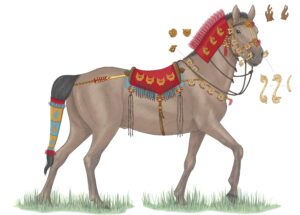Editor’s note: Discover Kazakhstan is a new column dedicated to exploring the rich cultural heritage and natural wonders of the country. Each article explores various aspects of Kazakh life and history, offering insights and stories that highlight their unique significance.
The warlike tribe of giants with azure eyes
The term ‘Saka’ historically referred to numerous tribes living in the territories of present-day Kazakhstan (Jetysu), Central Asia (Pamir, Fergana, and Khorezm), Eastern Turkistan, and Afghanistan between the eighth century BCE and the first centuries of our era. The name of the tribes may be derived from the Scythian word saka, meaning ‘deer’, but this is not certain. We do not know if it was a self-designation or a name given to them by neighboring peoples.

Sakā Tigraxaudā tribute bearers to the Achaemenid Empire, Apadana, Persepolis, 6th century BC. Photo credit: Wikimedia Commons.
Although some Saka tribes were agriculturists and had notions of architecture and urbanism, the majority were engaged in horse and sheep breeding, and they predominantly led a nomadic lifestyle.

The teenage archer found at the Eleke Sazy burial mounds, wearing clothes studded with gold, close to the looted grave of his sister. Photo credit: Vicki Herring/Fitzwilliam Museum.
The Sakas were not a monolithic entity but a tapestry of cultures. Ancient texts offer glimpses into their multifaceted lives.
While enumerating various Saka tribes, Herodotus mentions the tribe of Orthocorybantes, who seem to correspond to the Sakas in pointed hats or the Massagetae. In the fifth century BCE, the ‘Sakas in pointed hats’ and the Massagetae inhabited the lower reaches of the Syr Darya, the southern regions of Kazakhstan, and Jetysu, the southeast of present-day Kazakhstan. Herodotus also writes about the Amyrgians, believed to be Sakas, who were fond of the fly agaric brew.
The Persians referred to one group of Sakas as the ‘Sakas beyond Sogdiana’ (‘parikani’ according to ancient authors). Their neighbors were the Saka haumavargā, who lived near the Pamir-Alay Mountains and in the Fergana Valley. The Iranians called their land Sakastan.
Warriors and horsemen
The Sakas were accomplished warriors, and their tribal organization provided an excellent foundation for their cavalry. They were known as magnificent horsemen, with their horses being renowned for their endurance. The Sakas had perfected many details of making horse harnesses. This is not surprising as horse breeding and horsemanship have been known in Kazakhstan since the Chalcolithic period. Sakas also had infantry warriors, mounted archers, as well as cataphracts—riders who fought in armor armed with spears and long swords. The latter category of warriors belonged to the Saka elite.

Battle scenes between “Kangju” Saka warriors, from the Orlat plaques (1st century CE). Photo credit: Wikimedia Commons.
The military achievements of the Sakas were highly respected by their contemporaries. It is known that the Persian king Cyrus the Great (559–530 BCE) was killed in the battle with the Massagetae, and that he was killed by the Sakas in pointed hats. The army of Alexander the Great had squadrons of Saka horsemen, and his legionaries were defeated by the Sakas in a battle that took place near the Jaxartes River (modern-day Syr Darya).
Appearance and language

Head of a Saka warrior, as a defeated enemy of the Yuezhi, from Khalchayan, northern Bactria, 1st century BC. Photo credit: Wikimedia commons.
Descriptions of the Sakas’ physical features are scant, but historical accounts from the Anabasis of Alexander mention their impressive stature, with Saka warriors towering over Alexander the Great’s tallest soldiers. Some Chinese sources allude to green or azure eyes, red hair, and fair complexions among certain Saka tribes. Archaeological evidence suggests a diverse group, with some resembling modern Kazakhs and Kyrgyz, as depicted in reliefs at Persepolis, while others exhibited features more common in Afghanistan.
The Sakas spoke languages that are believed to belong to the Indo-European family. While their linguistic affiliations remain somewhat elusive, recent archaeological discoveries, such as the Issyk inscription and the trilingual inscription from Dasht-e Nawur, are gradually shedding light on their languages. These findings suggest that Saka languages were not only spoken but also used for official inscriptions in the Kushan Empire.
Burial customs and beliefs
Saka society was hierarchical, with leaders buried in large mounds, warriors in smaller ones, and commoners in simple graves. Leaders were buried in wooden or stone tombs with valuable items.

Issyk kurgan. Photo credit: Reserve Museum Issyk.
Saka ideology drew from Indo-Iranian myths, with the sun god holding the central role. The Issyk Kurgan, a looted royal tomb, revealed valuable items, including the “Golden Man” adorned with gold and symbols of power. The Golden Man’s attire, including a golden headdress and jacket, reflected Saka beliefs and their understanding of the cosmos. The symbolism on the attire, including animal figures and the sun emblem, represented dominion over the universe.
Legacy

Horse. Burial mound Issyk (5-4 B.C.), Kazakhstan. Photo credit: Derzsi Elekes Andor/Wikimedia Commons.
The Sakas’ legacy extends far beyond their nomadic existence. Their migrations in the early centuries CE reshaped the face of Eurasia. It can be argued that the Sakas played a substantial role in the formation of peoples such as the Kazakhs, Kyrgyz, Uzbeks, Karakalpaks, Tajiks, and some peoples of Afghanistan (Dards), Iran, India, and China. Their name is possibly linked to the names used for the Yakuts (Sakha), Kazakhs (Sayaki), and Turkmens (Sakha).
The era of the Sakas coincided with two epochs in traditional European historiography: antiquity and the Hellenistic period. The contribution of the Sakas to the history of Asia can be compared to the influence that ancient culture and the achievements of Hellenistic city-states had on the nomadic peoples surrounding them.
Based on an original article by Alisher Akishev, Kazakh historian and archaeologist. The full article can be found on the Qalam project website.


